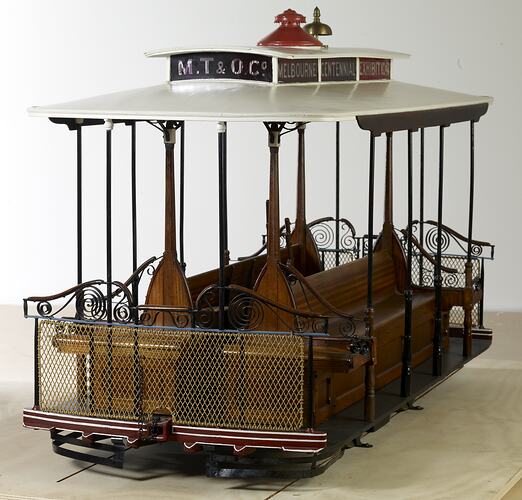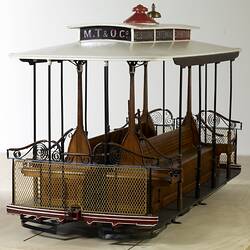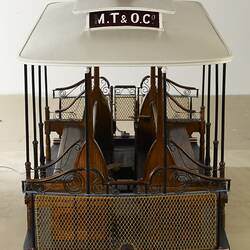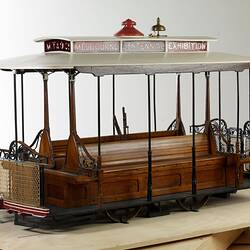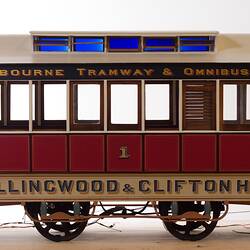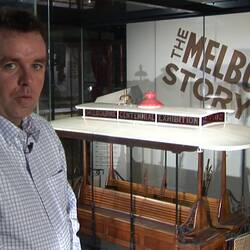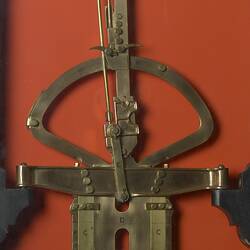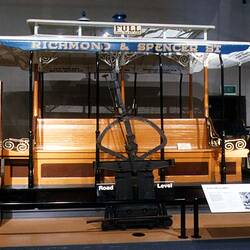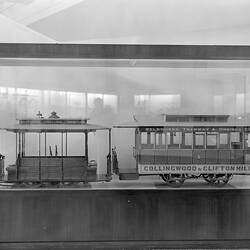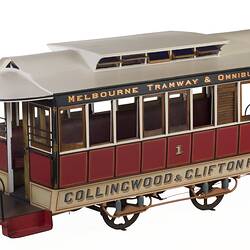Summary
Model of a cable tram grip car or 'dummy' and trailer or saloon car similar in design to the type used in Melbourne from 1885 to 1940, by the Melbourne Tramway & Omnibus Company and later the Melbourne & Metropolitan Tramways Board. Model, scale 1:4.
This beautifully detailed quarter-scale model of a Melbourne cable tram has an interesting history. The rear saloon car is believed to have been displayed at the 1880 Melbourne International Exhibition as an American-style horse tram, to promote the proposed introduction of horse trams in Melbourne. Apart from minor details to the roof and an extra window on each side, it is similar in appearance to the trailer cars used on Melbourne's cable trams. In 1888 it was again on display in its present form at the Melbourne Centennial Exhibition with a grip or dummy car added to promote the introduction of cable trams in Melbourne.
Each of Melbourne's cable trams was painted in a distinct colour scheme to designate the route on which it operated. The saloon car in the model is painted in red and white representing the Collingwood and Clifton Hill route that opened on 10 August 1887. Trams on this route travelled along Bourke Street, then Nicholson Street, before turning right into Gertrude Street opposite the Exhibition Building and continuing along Smith Street and Queens Parade to terminate near Merri Creek. The route was extended in February 1890 by a separate privately built cable tram service that ran up High Street through Northcote to Dundas Street, Preston.
Operating between 1885 and 1940, Melbourne's cable tram system was the world's fourth largest, encompassing at its peak, 17 routes running over 75 kilometres of double track. The system was largely constructed by the Melbourne Tramways Trust that was formed by act of parliament in October 1883 and included representatives from Melbourne's 12 inner municipal councils. The first cable tram route running from Richmond to Spencer Street along Bridge Road and Flinders Street, opened for traffic on 11 November 1885. It was followed over the next six years by routes to North Fitzroy, Abbotsford, Clifton Hill, East Brunswick, Brunswick, St Kilda, Prahran & Toorak, North Carlton, North & West Melbourne, South & Port Melbourne and the St Kilda Esplanade. As each line was completed it was leased to the Melbourne Tramway & Omnibus Company, which operated the system until it reverted to government control in 1916.
Cable tram technology was originally developed in the United Stated during the 1870s, and at the time it was introduced in Melbourne offered the world's most superior form of public transport. Its smooth riding, smokeless, dustless and almost noiseless vehicles were capable of operating with high passenger capacity at frequent intervals and rapid speed. Cable trams depended for their motive power on a continuously moving cable which ran on pulleys in a tunnel beneath the roadway. Melbourne's cable tram system was operated by 26 cables, driven by large steam engines situated in twelve engine houses distributed throughout the system.
Each grip car or 'dummy' had a grip mechanism which extended through a slot running down the centre of the tracks to clasp the cable and impart its motion to the tram. To stop the tram the grip man first moved the grip lever forward to release the cable and then applied one of two brake levers. The gripman's job required great skill and the same intimate knowledge of his route as a river pilot. As well as learning to pick up and release the cable without sudden jerks that might throw passengers from their seats, the gripman also had to know the precise spot to throw the cable free when rounding tight corners or crossing other tram tracks, leaving the tram with sufficient momentum to clear the intersection. At such points the gripman would give a short tug on the bell cord to warn passengers sing out 'Hold On' or 'Mind the Curve!'
Melbourne's cable trams were so popular that by 1889 they were carrying 46 million passengers a year and in their peak year of 1918 carried 119 million passengers. Fares ranged from a penny to threepence for a full through journey, with 1½ penny concession fares offered for workers during the morning and evening peak hours. Each tram car could carry 22 seated and 34 standing passengers in the saloon car and 20 seated passengers on the grip car with another 22 'hangers on' when crowed.
In 1919, the Melbourne & Metropolitan Tramways Board was formed to take over the cable tram network. In 1925 they began the gradual process of converting the over crowed and ageing cable tram routes for electric tram operation, which involved pulling up and relaying each line and installing overhead power wires. The Clifton Hill line was the last to close, with the last service departing Spencer Street for the Clifton Hill terminus at 9:17 pm on Saturday, 26 October 1940.
Physical Description
1:4 scale model of a cable tram grip car or 'dummy' and trailer or saloon car.
More Information
-
Collecting Areas
-
Acquisition Information
Donation from Royal Melbourne Institute of Technology (RMIT), 05 May 1955
-
Place & Date Made
United States of America, circa 1880
Trailer Car. -
Place & Date Made
Melbourne, Greater Melbourne, Victoria, Australia, circa 1888
Crip Car. -
Classification
-
Category
-
Discipline
-
Type of item
-
Overall Dimensions
3120 mm (Length), 600 mm (Width), 790 mm (Height)
Dimensions of model only - accurate to +/- 10 mm only.
-
Part Dimensions
1220 mm (Length), 570 mm (Width), 790 mm (Height)
Estimated dimensions Dummy or Grip Car - accurate to +/- 10 mm only. Track gauge of wheels = 355 mm.
-
Part Dimensions
1715 mm (Length), 600 mm (Width), 750 mm (Height)
Estimated Dimensions of Saloon Car or Trailer - accurate to +/- 10 mm only. Track gauge of wheels = 355 mm.
-
Case Dimensions
3200 mm (Length), 1000 mm (Width), 2200 mm (Height)
External display case dimensions.
-
Model Scale
1:4
-
Keywords
